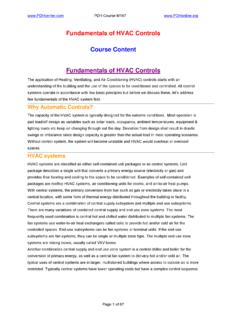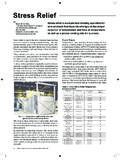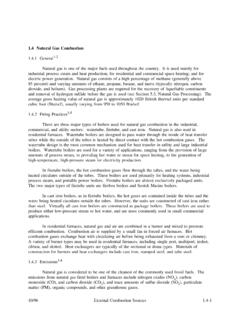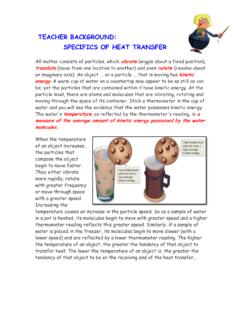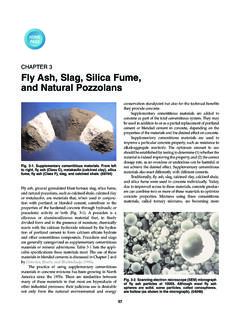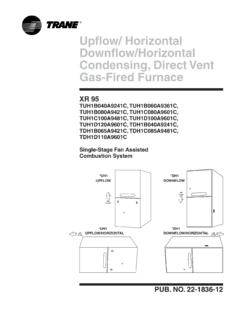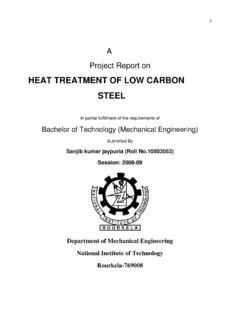Transcription of Waste Heat Reduction and Recovery for Improving Furnace ...
1 A BestPracticesProcess Heating Technical BriefWaste heat Reduction and Recoveryfor Improving Furnace Efficiency, Productivity and Emissions Department of EnergyEnergy Efficiency and Renewable EnergyBringing you a prosperous future where energy is clean, abundant, reliable, and affordableIndustrial Technologies ProgramBoosting the productivity and competitiveness of industry through improvements in energy and environmental performance1 BestPractices Technical BriefWaste heat Reduction and Recovery for Improving Furnace Efficiency, Productivity, and Emissions PerformanceWaste heat Reduction and Recovery for Improving Furnace Efficiency, Productivity, and Emissions Performance IntroductionThermal efficiency of process heating equipment, such as furnaces, ovens, melters, heaters, and kilns is theratio of heat delivered to a material and heat supplied to the heating equipment. For most heating equipment, alarge amount of the heat supplied is wasted in the form of exhaust or flue gases.
2 These losses depend on vari-ous factors associated with the design and operation of the heating equipment. This technical brief is a guideto help plant operators reduce Waste heat losses associated with the heating technical brief supports or complements the software tool Process Heating Assessment and Survey Tool(PHAST) developed jointly by the Industrial Heating Equipment Association (IHEA) and the Departmentof Energy s (DOE) Industrial Technologies Program. heat Losses from Fuel-Fired Heating heat losses are unavoidable in the operation of all fuel-fired furnaces, kilns, boilers, ovens, and dry-ers. Air and fuel are mixed and burned to generate heat , and a portion of this heat is transferred to the heatingdevice and its load. When the energy transfer reaches its practical limit, the spent combustion gases areremoved (exhausted) from the Furnace via a flue or stack to make room for a fresh charge of combustiongases. At this point, the exhaust flue gases still hold considerable thermal energy, often more than what wasleft behind in the process.
3 In many fuel-fired heating systems, this Waste heat is the greatest source of heatloss in the process, often greater than all the other losses combined. Reducing these losses should be a high priority for anyone interested in Improving the energy efficiency offurnaces and other process heating first step in reducing Waste heat in flue gases requires close attention and proper measures to reduce allheat losses associated with the Furnace . Any Reduction in Furnace heat losses will be multiplied by the overallavailable heat factor. This could result in much higher energy savings. The multiplier effect and available heatfactor are explained in greater detail in the following sections. These Furnace losses include: heat storage in the Furnace structure Losses from the Furnace outside walls or structure heat transported out of the Furnace by the load conveyors, fixtures, trays, etc. Radiation losses from openings, hot exposed parts, etc. heat carried by the cold air infiltration into the Furnace heat carried by the excess air used in the burners.
4 All of these losses can be estimated by using the PHAST software tool or the ITP s Process Heating TipSheets, available on the DOE s BestPractices Web site at Reducing Waste heat losses brings additional benefits, among them: Lower energy component of product costs Improved Furnace productivity Lower emissions of carbon monoxide (CO), nitrogen oxides (NOx) and unburned hydrocarbons (UHCs) May contribute to more consistent product quality and better equipment Technical BriefWaste heat Reduction and Recovery for Improving Furnace Efficiency, Productivity, and Emissions Performance What Determines Waste -Gas Losses?To answer this, the flow of heat in a Furnace , boiler, or oven must be understood. The purpose of a heatingprocess is to introduce a certain amount of thermal energy into a product, raising it to a certain temperature toprepare it for additional processing, change its properties, or some other purpose. To carry this out, the productis heated in a Furnace or oven.
5 As shown in Figure 1, this results in energy losses in different areas and , the metal structure and insu-lation of the Furnace must be heatedso their interior surfaces are aboutthe same temperature as the productthey contain. This stored heat isheld in the structure until the fur-nace shuts down, then it leaks outinto the surrounding area. The morefrequently the Furnace is cycledfrom cold to hot and back to coldagain, the more frequently thisstored heat must be replaced. In addition, because the furnacecannot run production until it hasreached the proper operating tem-perature, the process of storing heatin it causes lost production is consumed with no heat losses take place while the Furnace is in produc-tion. Wall or transmission losses are caused by the conduction of heat throughthe walls, roof, and floor of the heating device, as shown in Figure 2. Once thatheat reaches the outer skin of the Furnace and radiates to the surrounding area oris carried away by air currents, it must be replaced by an equal amount takenfrom the combustion gases.
6 This process continues as long as the Furnace is atan elevated handling furnaces use equipment to convey the workinto and out of the heating chamber, and this can also lead to heat losses. Con-veyor belts or product hangers that enter the heating chamber cold and leave itat higher temperatures drain energy from the combustion gases. In car bottomfurnaces, the hot car structure gives off heat to the room each time it rolls outof the Furnace to load or remove work. This lost energy must be replaced when the car is returned to the fur-nace. Cooling media or air cooling protects rolls, bearings, and doors in hot Furnace environments, butat the cost of lost energy. These components and their cooling media (water, air, etc.) become the conduit foradditional heat losses from the Furnace . Maintaining an adequate flow of cooling media is essential, but it mightbe possible to insulate the Furnace and load from some of these (opening) and ovens operating at temperatures above 1,000 F might have significant radiation losses, as shown inFigure 3.
7 Hot surfaces radiate energy to nearby colder surfaces, and the rate of heat transfer increases with thefourth power of the surface's absolute temperature. Anyone who has ever stood in front of the open door of aFlue lossesWall lossOpening lossUseful output( heat to load)Coolingwater lossand/or conveyorStoredheatGrossfuelinputNetfueli nputAvailableheatFigure 1. heat losses in industrial heating SkinFigure 2. Wall Technical BriefWaste heat Reduction and Recovery for Improving Furnace Efficiency, Productivity, and Emissions Performancehigh-temperature Furnace can attest to the huge amount ofthermal energy beamed into the or anytime there is an opening in the furnaceenclosure, heat is lost by radiation, often at a rapid openings include the Furnace flues and stacks them-selves, as well as doors left partially open to accommodateoversized work in the the losses mentioned above heatstorage, wall transmission, conveyor and radiation compete with the workload for the energy released by the burning fuel-air mixture.
8 However, these losses could bedwarfed by the most significant source of all, which iswaste-gas loss, also known as flue gas or stackloss, is made up of the heat that cannot be removedfrom the combustion gases inside the Furnace . Thereason is heat flows from the higher temperaturesource to the lower temperature heat effect, the heat stream has hit bottom. If, forexample, a Furnace heats products to 1,500 F, thecombustion gases cannot be cooled below this tem-perature without using design or equipment that canrecover heat from the combustion gases. Once thecombustion products reach the same temperature asthe Furnace and load, they cannot give up any moreenergy to the load or Furnace , so they have to bediscarded. At 1,500 F temperature, the combustion products still contain about half the thermal energy put intothem, so the Waste -gas loss is close to 50% (Figure 4). The other 50%, which remains in the Furnace , is calledavailable heat . The load receives heat that is available after storage in Furnace walls, and losses from furnacewalls, load conveyors, cooling media and radiation have makes it obvious that the temperature of a process, or more correctly, of its exhaust gases, is a major fac-tor in its energy efficiency.
9 The higher that temperature, the lower the efficiency. Another factor that has a powerful effect is the fuel-air ratio of the burner every fuel, there is a chemically correct,or stoichiometric, amount of air required to burn it. Onecubic foot of natural gas, for example, requires about 10cubic feet of combustion air. Stoichiometric, or on-ratiocombustion will produce the highest flame temperatures andthermal efficiencies. However, combustion systems can be operated at otherratios. Sometimes, this is done deliberately to obtain certainoperating benefits, but often, it happens simply because theburner system is out of adjustment. The ratio, as shown inFigure 5, can go either rich (excess fuel or insufficient air)01020304050607080901000100020001200% 1000%800%600%400%300%250%200%150%100%50% 25%10% Fuel: Birmingham Natural Gas (1002 Btu/cu ft, sp gr)Exhaust Gas heat Loss, % of Input0% Excess Air3000 Exhaust Gas Temperature, FCorrect RatioProcess EfficiencyRicherLeanerAir-Gas RatioFigure 5.
10 Effect of off-ratio operation on Furnace 4. Exhaust gas heat losses vs. exhaust gas temperature and air-gas loss from heated to colder Technical BriefWaste heat Reduction and Recovery for Improving Furnace Efficiency, Productivity, and Emissions Performanceor lean (excess air). Either way, it wastes fuel. Because there is not enough air for complete combustion, oper-ating the burners at rich combustion conditions wastes fuel by allowing it to be discarded with some of itsenergy unused. It also generates large amounts of carbon monoxide (CO) and unburned hydrocarbons (UHCs). At first glance, operating lean might seem to be a better proposition because all the fuel is consumed. Indeed,a lean operation produces no flammable, toxic by-products of rich combustion, but it does Waste air has two effects on the combustion process. First, it lowers the flame temperature by diluting thecombustion gases, in much the same way cold water added to hot produces warm water.










